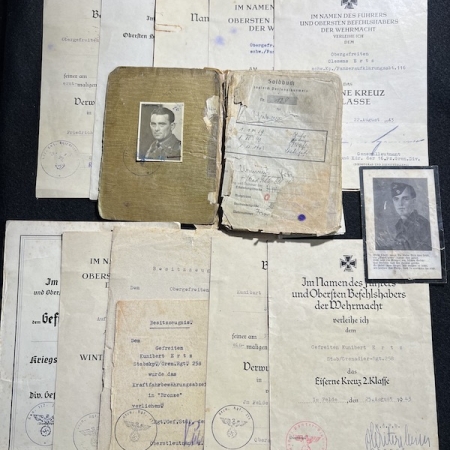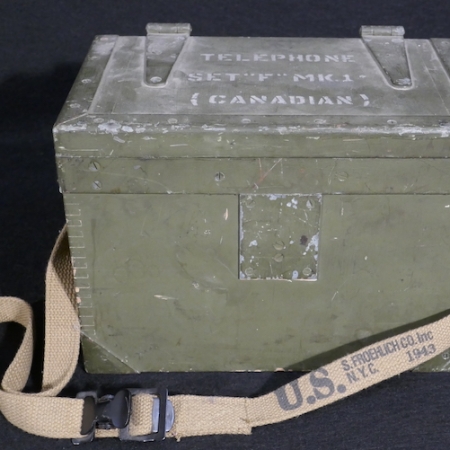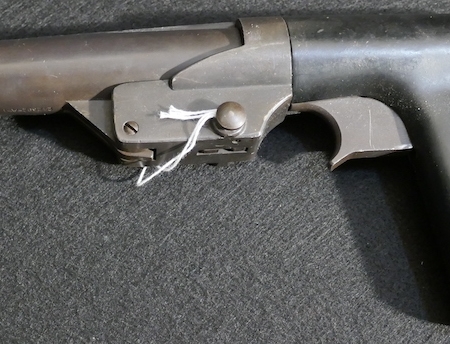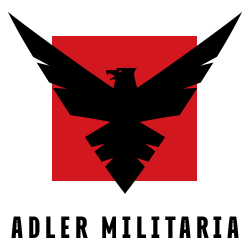Showing 145–153 of 1081 resultsSorted by latest
-

WWII German Three Brothers Grouping – Clemens, Kunibert and Anton Ertz – Waffen SS KIA in Caen, Normandy – Panzer Recon Der Windhund – Panzer A.A 116 – Soldbuch Urkunden Iron Cross Signatures – Rare Grouping
An incredible lot to three brothers: Stabsgefreiter Clements Ertz (Panzer Recon 116 – Der Windhund) Born in 1916, he would fight in the Machine Gun Section, of the Krad Schutzen Batl 165 – Fighting in Russia. Unit was equipped with Motor Bikes and Sidecars. Later moved into the Heavy Company Panzer Recon 116 (schw.Kp/ Panzeraufklärungsabt 116) (Windhund) He was issued with a MP40, and won the following awards as per the Soldbuch: West Wall Medal 1940 – With Certificate War Merit Cross With Swords – August 1941 – Signed by Generalmajor Generalleutnant Johannes Streich (Knights Cross) Commander of the 16th Infanterie Division Eastern Front Medal – Panzer Recon Abt 116 – Signed by Abt Leader . Iron Cross Second Class – August 1943 – Signed by Generallt Gerhard Helmut Detleff Graf von Schwerin (23 June 1899 – 29 October 1980) was a German General der Panzertruppe during World War II (Knights Cross Oak & Swords) Drivers Badge – Panzer recon 116 – All three grades till Gold It seems he fought with them till around late in 1943, note the Soldbuch photo in the Panzer or StuG Wrap as collectors call them where he falls ill, this means he is moving in and out of service. The Windhund have an amazing Battle History and were one of the most interesting Heer Units fighting on both fronts. Comes with his RAD Paper and the POW release Paper. Interestingly he used this as evidence for his War Pension in 1954. https://en.wikipedia.org/wiki/116th_Panzer_Division_(Wehrmacht) Next Brother : SS Sturmmann Anton Ertz – Waffen SS – Likely with the Hitlerjugend KIA in Caen on the 19th of July 1944 – he was buried in St honovine, but was called according to the archives in Germany as killed in : Amaye near Caen and is buried today in La Cambe. According to his death Card, he was a Messanger on a Motorbike and was awarded the Assault Badge. He was 18 years old when he was killed in action. Next Brother: Kunibert Erz – He served with the Recon Abteilung 120 (A.A 120) fighting in Russia, he was awarded the following awards: War Merit Cross – A.A 120 – 1942 – Signed 112 Infanterie Division Commander – Generallt Friedrich Mieth (4 June 1888 – 2 September 1944) was a German general during World War II. In 1942, he commanded Army Group Don Rear Area.[1] Mieth was killed in action on 2 September 1944 in Iași, Romania. Knights Cross Oak & Swords) KIA Rare signature. Eastern Front Medal – A.A 120 – Signed by Hauptmann and Regiment Commander of the Grenadier regiment 258 Drivers Badge in Bronze (Soldbuch Insert) and Drivers badge in Gold – Grenadier Regiment 258 Wounds Badge in Black – Grenadier regiment 258 – Signed Oberst and regimental Commander Iron Cross Second Calss – August 1943 – Grenadier Regiment 258 – Signed by an Oberst . It seems that Kunnibert went missing in January 1945 in the East of Germany and he was never found. Last Comments Quite the story of a sad reality, From the Three Brothers only one made it home. A rare grouping touching both the Western and Eastern Front and some of the most formidable battles in Normandy.
-

WWII German Wehrmacht Soldbuch – Hauptmann Gehrke – 246 Volksgrenadier Division – Aachen – Iron Cross First Class Aachen Battles against US Troops – Captured Rare
$485.00The pay book belonged to customs inspector Richard Gehrke, who was born in 1904, and was issued on January 26, 1943 by the Grenadier Replacement Battalion 110. Interestingly, it bears the number 1. At this time Gehrke was a first lieutenant in the reserve. The Gren.Ers.Btl. represented the replacement for the 79th Infantry Division, which was on the Eastern Front at the time, so that Gehrke’s presumably first deployment to the front took him to the 886 Grenadier Regiment of this very division. During his deployment on the Eastern Front, he contracted typhoid fever in September 1943, which kept him busy for a good two months, led him to various hospitals and finally to the Truscawiecz army convalescent home (presumably located in Poland). However, the infection seems to have healed without any consequences and Gehrke returned to his troops, because on February 4, 1944 he was awarded the EK2 by the 79th ID. He also changed units within the division at an unspecified point in time and was deployed to Grenadier Regiment 212 for a while (coming from Grenadier Replacement Battalion 212). At the end of April 1944, Gehrke was admitted to a hospital with an injury that he must have sustained in an accident (code 34). On July 1, 1944, Gehrke was promoted to captain in the reserve, and here an inconsistency occurs: The promotion was carried out by the unit with the field post number 23353 (if I deciphered the number correctly), which is assigned to the field replacement battalion 246. However, this unit does not appear on page 4 as a replacement unit, especially since the 246th ID no longer existed at that point. However, I can’t imagine that this could be a coincidence or wrong. Perhaps he was briefly intended for the division’s re-formation as the 246th VGD? Be that as it may, his stay with the 149th Staff and Grenadier Regiment of the 49th Infantry Division is assured. This division was a ground-based, non-mobile unit in the Boulogne area and did NOT take part in the fighting there after the landing in Normandy. Instead, it withdrew to the area west of Paris and had initial enemy contact in the defense of the Seine crossings. The bulk of the division was captured in the Mons pocket. Gehrke was not one of them; he appears to have been one of only around 1,500 men to escape the cauldron. With regular enemy contact, the division withdrew further towards Reich territory via Belgium and Holland and crossed the border at Aachen. At the end of September, on the eve of the 2nd Battle of Aachen, the division was reorganized and fresh troops were added to it. On October 1st it had a combat strength of around 5,100 men (9,400 total) and was fighting on the northern edge of Aachen (Alsdorf, Merkstein, Palenberg, Kohlscheid for those who know their way around) against the American 29th US Infantry -Division. Gehrkte probably experienced these fights first hand. At Aachen the division was again almost completely wiped out. It lost so much of its fighting strength that it virtually ceased to exist and on October 23rd the pitiful remnants were incorporated into the 246th VGD, which had also been badly beaten near Aachen, on the arbitrary orders of Field Marshal Models. Gehrke’s unit, the Grenadier Regiment 149, was probably incorporated into the Grenadier Regiment 689. Once again, as in Mons, Gehrke must have been one of the few in his unit who survived the Aachen disaster and were not taken prisoner, because on November 19th the 246th VGD awarded him the EK1. At this point the 246th VGD was standing. in the defensive battle east of Aachen an der Rur. The EK1 is the last official entry, but the prisoner of war number written in bold on page 1 proves that Gehrke also survived the later fighting and was taken prisoner either in the North or Schnee Eifel (the division was for a short time in the Monschau area next to the 272nd VGD was deployed, but was later relocated to the area west of Stadtkyll to strengthen the former Ardennes Front). Removed from Consignment
-

WWII Imperial Japanese Navy – Type 3 KAI – Tokyo Aero Indicator Co – Mitsubishi G4M Type 1 Bomber Betty – Very Rare
This is a WWII-era direct reading, reflector, magnetic compass,Type 2 or 3 KAI , made by Tokyo Aero Indicator Co, as used in aircraft of the Japanese Navy. According to the online Funatsu Aviation Instruments Museum, this compass was used in the following aircraft: Mitsubishi G4M Type 1 Bomber Betty Nakajima B6N Tenzan Torpedo Bomber Kate Type94 Recon Kawanishi E7K Type 95 Model 2 Recon Nakajima C6N Saiun Myrt The box is period, along with all the extras – we have not had anything in this condition as usually these are taken from downed or crashed aircraft. This example is in the box like it came out of the factory.
-

WWII British Royal Air Force Navigational Compass – Spitfire – Hurricane – Mosquito – Beaufighter – Crown Marked AM 6A/726 –
The Type P8 Navigational Compass, Ref 6A/0726, was used across numerous aircraft of the British Royal Air Force during WWII, including Spitfire, Hurricane, Mosquito, and Beaufighter. Original
-

WWI US AEF – Chaplain LeVeer – Table Service Crusifix and Wooden Box – 26th Division Yankee – Original Rare (Offer Accepted)
Chaplain Arthur Joseph LaVeer was born along the Connecticut River in the Northeast Kingdom (a regional name) town of Bloomfield, Vermont on February 3rd, 1886. Commissioned as a 1st Lt. on August 22nd, 1918, LeVeer was quickly sent overseas to serve as a chaplain with the 102nd Infantry Regiment of the 26th “Yankee Division.”Father LeVeer served at St. Norbert’s Church in Hardwick for the remainder of his life. Photo – Found on the web, shows LeVeer in uniform and later in life. (Last 4 photos are reference only) Incredibly rare items If your interested in learning more about this Chaplain I was able to find very good info from this website; Thanks to Mr Gauthier. https://portraitofwar.com/2017/02/28/wwi-26th-division-chaplain-photo-bloomfield-vt-native-arthur-leveer-in-france-1918/
-

WWII Canadian Army – Telephone Set F MK.1 – 1943/1944 – Original
Nicely marked Canadian WW2 gear is not the easiest to find.
-

WWII US Navy Signal Pistol 1943 Dated – Signal Pistol Mark 5 R.F. Sedgley Inc 1943 – Original
Original Signals Pistol 1943 Dated US Sales only
-

WWI WWII US Marine Corps Sniper Scope – USMC M1903 – Winchester A5 Sniper Scope – Original
Here we have a Winchester A5 Sniper Scope . Photos in use are only for reference. WWI & WWII with the USMC. Optic is a little dusty but the cross hairs are still complete.
-





